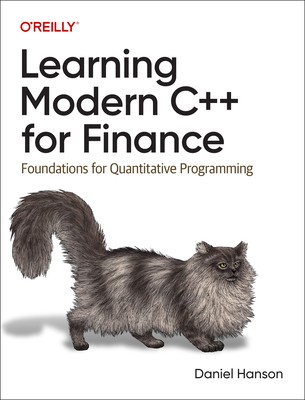
- We will send in 10–14 business days.
- Author: Daniel Hanson
- Publisher: O'Reilly Media
- ISBN-10: 1098100808
- ISBN-13: 9781098100803
- Format: 17.8 x 23.3 x 2.2 cm, softcover
- Language: English
- SAVE -10% with code: EXTRA
Reviews
Description
A lot of financial modeling has gravitated toward Python, R, and VBA, but many developers hit a wall with these languages when it comes to performance. This practical book demonstrates why C++ is still one of the dominant production-quality languages for financial applications and systems. Many programmers believe that C++ is too difficult to learn. Author Daniel Hanson demonstrates that this is no longer the case.
Financial programmers coming from Python or another interpreted language will discover how to leverage C++ abstractions that enable safer and quicker implementation of financial models. You'll also explore how popular open source libraries provide additional weapons for attacking mathematical problems. C++ programmers unfamiliar with financial applications will also benefit from this handy guide.
- Learn C++ basics: syntax, inheritance, polymorphism, composition, STL containers, and algorithms
- Dive into newer features and abstractions including functional programming using lambdas, task-based concurrency, and smart pointers
- Employ common but nontrivial financial models in modern C++
- Explore external open source math libraries, particularly Eigen and Boost
- Implement basic numerical routines in modern C++
- Understand best practices for writing clean and efficient code
EXTRA 10 % discount with code: EXTRA
The promotion ends in 18d.12:52:31
The discount code is valid when purchasing from 10 €. Discounts do not stack.
- Author: Daniel Hanson
- Publisher: O'Reilly Media
- ISBN-10: 1098100808
- ISBN-13: 9781098100803
- Format: 17.8 x 23.3 x 2.2 cm, softcover
- Language: English English
A lot of financial modeling has gravitated toward Python, R, and VBA, but many developers hit a wall with these languages when it comes to performance. This practical book demonstrates why C++ is still one of the dominant production-quality languages for financial applications and systems. Many programmers believe that C++ is too difficult to learn. Author Daniel Hanson demonstrates that this is no longer the case.
Financial programmers coming from Python or another interpreted language will discover how to leverage C++ abstractions that enable safer and quicker implementation of financial models. You'll also explore how popular open source libraries provide additional weapons for attacking mathematical problems. C++ programmers unfamiliar with financial applications will also benefit from this handy guide.
- Learn C++ basics: syntax, inheritance, polymorphism, composition, STL containers, and algorithms
- Dive into newer features and abstractions including functional programming using lambdas, task-based concurrency, and smart pointers
- Employ common but nontrivial financial models in modern C++
- Explore external open source math libraries, particularly Eigen and Boost
- Implement basic numerical routines in modern C++
- Understand best practices for writing clean and efficient code


Reviews